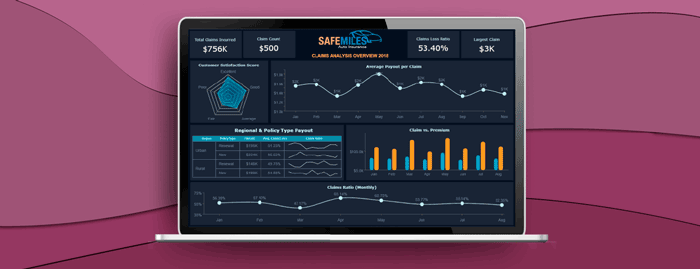Big data has transformed the way CEOs lead companies. A new era of decision intelligence is enabling faster, smoother, more effective decisions that are collectively redefining business strategy.
With the right data at the right time, businesses can act up to five times faster. And in a world plagued with increasing macroeconomic uncertainty, this level of agility is becoming necessary to survive.
As the C-suite demands accessible, real-time business intelligence, ad hoc reporting features are in the spotlight. Let’s take a look at how a trend toward self-service data is simplifying business intelligence for CEOs.
Big Data Brings More Capabilities and More Complexity
The majority–upwards of 93% of businesses continue to increase their investments in big data. For the past few years, data-driven analytics has been a common theme driving business strategy.
According to Deloitte, two-thirds (67%) of executives have some discomfort with new data-driven technologies. This leads them to rely on skilled talent within their organizations every time they need to access data.
The C-suite accesses data through a variety of interfacing tools, including:
- Visual dashboards
- Canned reports
- Data APIs in familiar CRM platforms
- Data sharing platforms
And these tools work but need change, and when they do, it takes days, weeks, or even months to build new tools.
That’s why a growing number of companies are leaning into the trend of self-service analytics like ad hoc reporting. These tools make it easier for non-technical roles (like the CEO) to pull data in a digestible report format without the help of the data science team.
How Ad Hoc Reporting Keeps Things Simple
While canned reports have their place, more CEOs are turning to ad hoc reporting features for timeliness and simplicity. Here’s a look at how these self-service reporting features can help leaders access the right data at the right time. They include:
- See Exactly What You Need
- Simple, Digestible Presentation
- Leverage Perfect Timing
- Do More with Actionable Insights
The biggest selling point for ad hoc reports is the ability to customize what you’re reporting on and to understand why something is or isn’t happening. These reports can be tailored to highlight key metrics, trends, or performance indicators relevant to the CEO's area of interest.
Canned reports still have their purpose and are often based on broad needs. These reports can be accessed by different departments for different needs. And while there is value in aggregate data, these reports sometimes lack the insight that is needed for big business decisions.
With ad hoc reporting, the CEO can pull data on demand for any metric that they need, which can be really useful for conducting a quick analysis in the moment. Let’s look at an example in retail. Sales and consumer preferences can be very regional. When trends emerge, they are often localized.
A canned report might provide aggregate sales data based on categories, but what if the CEO wants to see a breakdown of data by product and region? Ad hoc reporting can provide detailed, segmented views based on specific needs. And when those needs change–an ad hoc report can be utilized to pull new data based on entirely different metrics with the same granular level.
2. Simple, Digestible Presentation
Ad hoc reports typically present data in a condensed and digestible format. Ad hoc reports facilitate real-time data sharing of actionable intelligence. The simplified format with limited, precise information helps CEOs quickly scan and interpret the data so that they can save time making big decisions.
For example, if a finance team is trying to analyze the profitability of a new product, they can quickly see differences based on region, marketing output, or discounting. This accessibility can proactively fuel pricing optimization decisions that enable profitability that might otherwise be difficult to achieve.
Another key benefit of ad hoc reporting is on-demand or short-turnaround report generation. When the CEO doesn’t have to wait on the data science team to build a custom report, everything happens a lot faster.
This agility helps CEOs make quick decisions based on near real-time data, shifting the organization from reactive to proactive. According to a McKinsey & Co survey of more than 2,000 global executives, agility is everything.
Making the right decision at the right time can increase customer satisfaction by up to 30% while simultaneously reducing costs and improving efficiency by a similar margin. Even small shifts in agility can improve organizational efficiency by 5-10%.
4. Do More with Actionable Insights
The role of a CEO continues to expand in both scope and complexity. Between 1999 and 2006, the average tenure of a CEO was 10 years. Today, less than 40% make it to the two-year mark. Every business is different, but within those differences, the job of the CEO remains the same–to build the business and increase shareholder value.
The difference between CEOs who are just surviving the job compared to those who are building a legacy is action. Ad hoc reports are designed to provide quick, easy-to-digest, insights to facilitate strategic action.
Final Thoughts on Ad Hoc Reports
Over the past few years, businesses have embraced digital transformation and the vast opportunities available from data-driven business intelligence. And while data has fueled innovation and growth, it’s also added chaos and complexity.
Amid a steady stream of reporting capabilities, visual dashboards, and CRM integrations, executives are leaning towards self-service features like ad hoc reports to find clarity. These reports provide niche data on-demand and in real-time so that business leaders can see exactly what they need to know without all the clutter.































